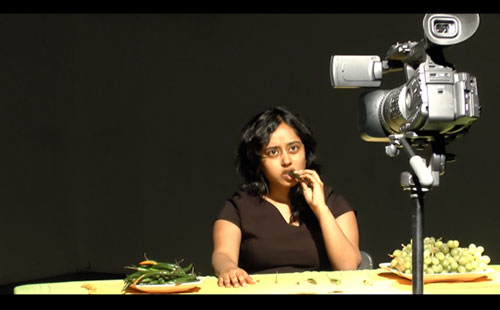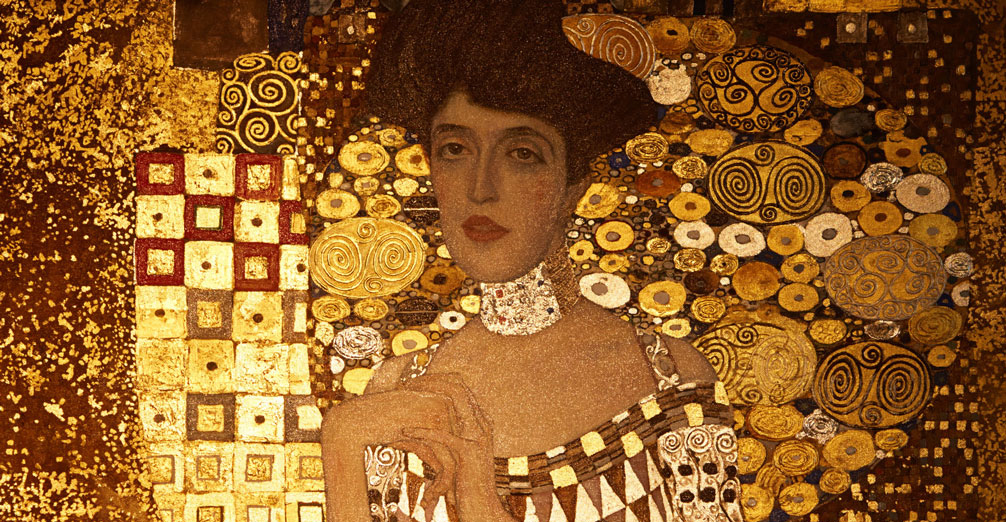Bow Ty and spectator/participants in Agreements of Collaborative Exchange photo by Emerson Granillo, Udita Upadhyaya performing The Chili Piece, photo courtesy of the artist.
Since my initial introduction to the artists in August of 2014, I have engaged with their work through participation and in regular viewings.
Performance artists Bow Ty and Udita Upadhyaya attempt to work against the comfortable and the predictable. Both artists emerge from “new media” practices, and engage their audiences through reexaminations of the seemingly ordinary and the everyday. Bow Ty and Upadhyaya perform often, participating in collaborations and festivals, and they are MFA students at the School of the Art Institute of Chicago (SAIC).
For both artists, personal experiences have led to the exploration of fear, discomfort and anxiety in very public ways. “Endurance,” a word that has become synonymous with performance art through the seminal works of Marina Abramovic, William Pope.L, Vito Acconci, and others, is an important aspect of both artists’ work. How far can the body go? What are the limitations of the artist’s comfort zone? These are questions that motivate, scare, and compel Upadhyaya and Bow Ty to resist the safe confines of the mundane. For example, The Chili Piece, in which Upadhyaya ingested chili peppers continuously for 45 minutes, is a contemporary iteration of “endurance” practice. Spot lit, the artist sat at a table in silence while slowly biting into and swallowing each chili in front of a camera. She was dressed simply in black, her dark tousled hair framing her face. Tears streamed down her cheeks, and her nose dripped as she softly tried to contain her discomfort.
It is likely that many students at SAIC have met Bow Ty. Not long before I met him, the artist set out to meet the entire student and staff population of the school in a performance he titled The Networking Project. Hoping to connect with others and find friends, Bow Ty would introduce himself then start a simple conversation with each new acquaintance. He then took down the person’s name, and as a means to remember the person and the meeting, asked to take a selfie. He asked new acquaintances about their dreams and when possible, traded objects as tools to remember his new acquaintances. Upadhyaya introduced me to Bow Ty at an exhibition, and when I met him, he asked me to supply him with a question that he would deliver to the acquaintance whenever we met. Being new to the city, I came up with “How are you adjusting to Chicago?”
After aiming to meet the entire SAIC population, Bow Ty ended The Networking Project after meeting approximately 2700 people, roughly 60 percent of the SAIC staff and student body. Until very recently, Bow Ty was typically eccentrically dressed. He was often seen wearing flamboyant and outlandish ensembles that could include anything from pantaloons to a floral dress over jeans. Bow Ty’s appearance was carefully constructed, and he began dressing in this fashion fairly early in his artistic practice: “The wardrobes was one of the first things I started doing. I thought that if I were to become something strange, or “other” to people, then we would have to negotiate that together.”
When Bow Ty began considering students’ motivations for attending art school, and how their time at SAIC may help them after graduation, he started The Networking Project. “I wanted to think about networking as an institutionalized concept, and something which is subject to critique. I often find it quite shallow, but what would happen if I turned that idea around? What if I actually tried to take this expectation, this ideal [seriously], as if I actually believed in it?”
Born in Bombay, Upadhyaya is more than aware of her foreignness in an American space and of the stereotypes and associations Indian women are given. It is interesting then, that her food of choice is the chili pepper, something readily and often obliquely associated with Indian-ness and everything “spicy.” But Upadhyaya’s associations with food reach beyond national stereotypes, delving deep into a long-term struggle with food and its politics.
Upadhyaya sees the exploration of personal fear as a vehicle for others to confront their anxieties. “I’m presenting an opportunity for the audience to acknowledge their relationship with food, because everyone’s relationship to food is complicated,” she says.
The Networking Project was a way for Bow Ty to confront his own social anxiety. “With all my projects I’ve tried to focus on some kind of inhibition in me,” he said. That’s part of the tension in the work. I couldn’t just hide from myself and not talk to people.”
The conception of limits as both self-created structures and the capabilities of the artist are important. At some point during The Networking Project Bow Ty decided he had exhausted the extent of his exploration. “Often with these projects, you push yourself to the limits of a certain ideal,” he said. “In this case, it was my optimism towards networking.” The qualitative aspects of his project began to confuse his original intentions. He wasn’t interested in meeting people to rack up numbers.
Upadhyaya’s limits with The Chili Piece were equally psychological, albeit quite different: “Food takes over my body when it is in front of me, particularly when I am in a performative state. There was a lot of internal dialogue in the piece. It may have been visible when I was holding the table trying to figure out when I could stop.” In her “performative state” Upadhyaya revisits trauma and attempts to process it in public, but the total experience of the performance is predominantly internal, private.
For many people, even those within the art world, performance art’s more obvious pull is in the spectacle. Bow Ty was quite aware of the ways in which this could happen, particularly in regards to The Networking Project. He became concerned that his interactions with people were becoming formulaic and insincere: “I was aware of people thinking of me as a visual presentation of an idea instead of an actual person. This definitely became problematic for me, and I wondered whether the perception of me was detracting from the work.” Bow Ty said that he hoped “the spectacle” could operate as an entry point or a “by-product” of the performance.
Because active participation is so particular to performance, a straight answer to “Where does the work reside?” can be confusing. Bow Ty sees the work not in his selfies, nor in taking note of a stranger’s name, but in people: “The work resides in people who have I interacted with. They’re one of the central audiences because they experience the project in its truest form. They see me come up to them and have this experience of making initial judgments about who or what I am.”
In a more traditional sense, Udita’s practice tends to reside in the performance itself, which may span an evening or even a day. She is careful to document her performances through film and photography. However, physical residue from the performance lingers, as the chili peppers pass through her body during the course of the day. Her work has since developed from immediate associations to thinking about food in the context of need, development, and self-actualization.
While the artist is the most central aspect of a performance, much of the significance of performance art rests in the responses from viewers or audience. In a work currently in flux, Agreements of Collaborative Exchange, Bow Ty “traded” a favor with individuals in exchange for their attendance at his final MFA performance. He engaged in all kinds of favors, including helping a BFA student with a collage project, taking a friend out to dinner, and agreeing to participate in this interview.
At his last performance at SAIC, Bow Ty appeared to the audience, which included family, many friends, and collaborators in the performance, outside of the building. He was dressed in jeans and a t-shirt. No hats, no make up, no more wardrobe. Helped by his mother, Bow Ty deposited several bags of clothing on the ground in front of the crowd – the wardrobe that was part of his daily practice – for anyone to take. After attending his performance, Agreements of Collaborative Exchange will continue with new collaborators, in which Bow Ty will return the favor.
In viewing and participating in the work of performance artists, the simple acts of meeting people or eating food becomes an interrogation of how symbolism and objects function in society. Working in a genre that resists easy categorization, performance artists seek new boundaries, new lines to cross. Perhaps in these intersections the performer and the audience can see things differently. “I’m hoping to create a changed social experience,” said Bow Ty, “not only for myself, but for other people.”








